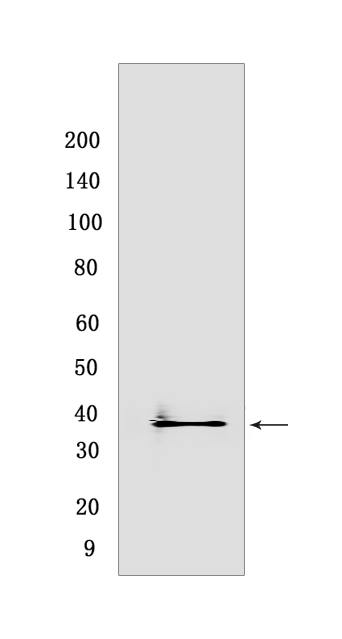Annexin A1/ANXA1 Rabbit mAb [X12E]Cat NO.: A43838
Western blot(SDS PAGE) analysis of extracts from Raw264.7 cells.Using Annexin A1/ANXA1Rabbit mAb [X12E] at dilution of 1:1000 incubated at 4℃ over night.
Product information
Protein names :ANXA1,ANX1,LPC1,ANXA1_HUMAN,Annexin A1 [Cleaved into: Annexin Ac2-26]
UniProtID :P04083
MASS(da) :38,714
MW(kDa) :38 kDa
Form :Liquid
Purification :Protein A purification
Host :Rabbit
Isotype :IgG
sensitivity :Endogenous
Reactivity :Human,Mouse,Rat
- ApplicationDilution
- 免疫印迹(WB)1:1000-2000
- The optimal dilutions should be determined by the end user
Specificity :Antibody is produced by immunizing animals with a synthetic peptide at the sequence of human Annexin A1/ANXA1
Storage :Antibody store in 10 mM PBS, 0.5mg/ml BSA, 50% glycerol. Shipped at 4°C. Store at-20°C or -80°C. Products are valid for one natural year of receipt.Avoid repeated freeze / thaw cycles.
WB Positive detected :Raw264.7 cells
Function : Plays important roles in the innate immune response as effector of glucocorticoid-mediated responses and regulator of the inflammatory process. Has anti-inflammatory activity (PubMed:8425544). Plays a role in glucocorticoid-mediated down-regulation of the early phase of the inflammatory response (By similarity). Contributes to the adaptive immune response by enhancing signaling cascades that are triggered by T-cell activation, regulates differentiation and proliferation of activated T-cells (PubMed:17008549). Promotes the differentiation of T-cells into Th1 cells and negatively regulates differentiation into Th2 cells (PubMed:17008549). Has no effect on unstimulated T cells (PubMed:17008549). Negatively regulates hormone exocytosis via activation of the formyl peptide receptors and reorganization of the actin cytoskeleton (PubMed:19625660). Has high affinity for Ca(2+) and can bind up to eight Ca(2+) ions (By similarity). Displays Ca(2+)-dependent binding to phospholipid membranes (PubMed:2532504, PubMed:8557678). Plays a role in the formation of phagocytic cups and phagosomes. Plays a role in phagocytosis by mediating the Ca(2+)-dependent interaction between phagosomes and the actin cytoskeleton (By similarity).., [Annexin Ac2-26]: Functions at least in part by activating the formyl peptide receptors and downstream signaling cascades (PubMed:22879591, PubMed:15187149, PubMed:25664854). Promotes chemotaxis of granulocytes and monocytes via activation of the formyl peptide receptors (PubMed:15187149). Promotes rearrangement of the actin cytoskeleton, cell polarization and cell migration (PubMed:15187149). Promotes resolution of inflammation and wound healing (PubMed:25664854). Acts via neutrophil N-formyl peptide receptors to enhance the release of CXCL2 (PubMed:22879591)..
Tissue specificity :Detected in resting neutrophils (PubMed:10772777). Detected in peripheral blood T-cells (PubMed:17008549). Detected in extracellular vesicles in blood serum from patients with inflammatory bowel disease, but not in serum from healthy donors (PubMed:25664854). Detected in placenta (at protein level) (PubMed:2532504). Detected in liver..
Subcellular locationi :Nucleus. Cytoplasm. Cell projection, cilium. Cell membrane. Membrane,Peripheral membrane protein. Endosome membrane,Peripheral membrane protein. Basolateral cell membrane. Apical cell membrane. Lateral cell membrane. Secreted. Secreted, extracellular space. Cell membrane,Peripheral membrane protein,Extracellular side. Secreted, extracellular exosome. Cytoplasmic vesicle, secretory vesicle lumen. Cell projection, phagocytic cup. Early endosome. Cytoplasmic vesicle membrane,Peripheral membrane protein.
IMPORTANT: For western blots, incubate membrane with diluted primary antibody in 1% w/v BSA, 1X TBST at 4°C overnight.


